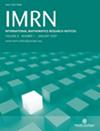(G,n)复数的取消与天鹅有限性障碍
IF 0.9
2区 数学
Q2 MATHEMATICS
引用次数: 0
摘要
在之前的工作中,我们将$G$具有周期同调时有限$(G,n)$复数的同调类型与代表斯旺有限性障碍的投影${/mathbb{Z}}相关联。代表斯旺有限性障碍的 G$ 模块。我们利用这一点来确定当 $X \vee S^{n}\simeq Y \vee S^{n}$ 对于有限的 $(G,n)$ 复数 $X$ 和 $Y$,意味着 $X \simeq Y$,并给出了当这种情况失效时同源不同对的数量下限。证明涉及构造投影 ${mathbb{Z}}G$ 模块作为四元数代数乘积阶上局部自由模块的提升,其存在性源于艾希勒质量公式。在 $n=2$ 的情况下,会出现一些困难,从而导致一种新的方法来寻找沃尔 D2 问题的反例。本文章由计算机程序翻译,如有差异,请以英文原文为准。
Cancellation for (G,n)-complexes and the Swan Finiteness Obstruction
In previous work, we related homotopy types of finite $(G,n)$-complexes when $G$ has periodic cohomology to projective ${\mathbb{Z}} G$-modules representing the Swan finiteness obstruction. We use this to determine when $X \vee S^{n} \simeq Y \vee S^{n}$ implies $X \simeq Y$ for finite $(G,n)$-complexes $X$ and $Y$, and give lower bounds on the number of homotopically distinct pairs when this fails. The proof involves constructing projective ${\mathbb{Z}} G$-modules as lifts of locally free modules over orders in products of quaternion algebras, whose existence follows from the Eichler mass formula. In the case $n=2$, difficulties arise that lead to a new approach to finding a counterexample to Wall’s D2 problem.
求助全文
通过发布文献求助,成功后即可免费获取论文全文。
去求助
来源期刊
CiteScore
2.00
自引率
10.00%
发文量
316
审稿时长
1 months
期刊介绍:
International Mathematics Research Notices provides very fast publication of research articles of high current interest in all areas of mathematics. All articles are fully refereed and are judged by their contribution to advancing the state of the science of mathematics.

 求助内容:
求助内容: 应助结果提醒方式:
应助结果提醒方式:


